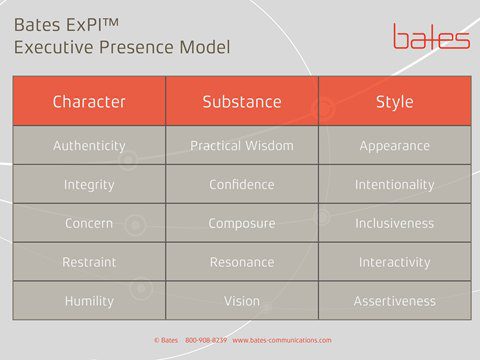Imagine this scenario: Two CEO succession candidates in a Fortune 500 company have impressive business careers. One is an energetic and extroverted leader who thrives on collaboration, the other is an introverted, analytical executive appreciated for his maturity and deliberative approach. Yet both received feedback from the boss and the board that they need to work on executive presence. How are they to act on that feedback? And how is a learning and development leader to interpret that and guide others to develop this X factor?
By looking at decades of empirical studies from across the globe on social action, leadership, management, communication, ethics and philosophy, a picture of executive presence emerges. The qualities of leadership that align purposeful action, mobilize above and beyond effort and lift organizational performance go beyond the traditional “command the room” presentation skills.
Under this lens, executive presence can be viewed as three dimensions — character, substance and style. The character dimension encompasses those aspects of temperament and disposition people begin developing early in life; substance is the cultivated, mature qualities specific to executive leadership; and style is those iterative, dialogical activities that enable execution. Within these dimensions, research suggests there are 15 distinct facets or qualities that enable leaders to inspire, motivate and influence others.
Research shows character is foundational to inspiring trust, goodwill and credibility. But assessing character doesn’t measure whether leaders have leadership qualities like humility, resonance or concern, only whether others seeit and experience it. When people see leaders’ characters in action, they want to follow them.
Learning and development professionals can guide a leader as he or she learns to amplify qualities of character that win trust. Doing this on a large scale can help to shape a culture of character throughout the organization. Accelerating development can start by encouraging leaders to reflect on their experiences and identify the leadership lessons that have defined them. Storytelling is a powerful tool leaders can use to amplify their character, substance and style.
Here are five steps to help enhance executive presence:
1. Define executive presence and create a common language. Show business leaders in the organization that executive presence is more than attire and the ability to command a room. Emphasizing all three dimensions — particularly the often-overlooked dimension of character — is important to help leaders have a deeper appreciation of this complex, multidimensional quality. Helping people understand the direct, scientifically proven connection between executive presence and business results is also vital.
2. Measure executive presence so executives have data with which to make decisions. One truth about executive presence: If it can be assessed, it can be addressed. All too often, leaders are told they need to work on executive presence without any real data to indicate what that might mean. With a robust assessment, any leader can understand exactly what about his or her presence is coming across loud and clear and where it may need work through professional development. The more specific the feedback, the easier it is to make it actionable.
3. Help leaders leverage their strengths to address developmental themes. When they get the data, most leaders will want to focus immediately on their lowest-rated facets. While this is natural, it’s crucial to first help them appreciate what their perceived strengths are and how they can be leveraged to address those facets that need development. For example, a leader who is strong in intentionality could apply that strength to improve qualities such as concern or resonance — taking care to be more intentional about checking with others on a regular basis. This strategy makes development seem more attainable, building self-efficacy in the leader.
4. Map executive presence in competency models and performance reviews. The executive presence model is complementary. If a leadership competency is to “influence courageously,” for example, expect that to show up in the facets related to practical wisdom, resonance and assertiveness.
5. Provide business-relevant context in feedback to engage leaders. To make the feedback specific, relevant and actionable, it has to connect strongly to the leader’s business context. First, understand the leader’s role, responsibilities, stakeholders, business imperatives and individual goals. Then show the leader specific ways he or she would be able to take action on developmental themes that are especially urgent and important. By the end of a one-hour feedback call, identify some clear, concrete first steps the leader can take to begin working on the developmental themes that matter most in that business context.















